“ABVP, Kaahe So Creepy?”: Hear Students of Delhi University from the Save DU March
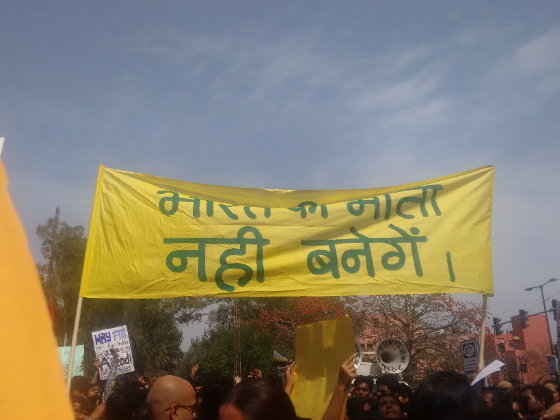
On February 28, students from various colleges in Delhi participated in a massive protest under the banner "DU Against Gundagardi". This was around a week after the Akhil Bharatiya Vidyarthi Parishad (ABVP) stalled a seminar, on "Cultures of Protest", organised by Ramjas College. The members of the ABVP did not think twice before harming their fellow students, teachers and journalists. (Souradeep Roy, a member of the Indian Cultural Forum was also subject to the ABVP's hooliganism.) Thousands of students reclaimed the streets of Delhi University. "Democracy does not speak in unison; its tunes are dissonant, and necessarily so":¹ this was the very nature of the students' protest. It accommodated a myriad voices — of students and teachers; voices that are often left unheard; and voices that have been (quite literally) silenced forever. These voices challenged the ABVP's narrow and singular discourse of a militant nationalism.
The women's student collective Pinjra Tod added a nuanced dimension to the protest. The collective astutely strung together a range of voices and concerns, bringing about an intersectionality that also questioned larger systemic problems; "Sanghi Police" was one such slogan. Pinjra Tod included a number of voices from marginalised sections. These are generally left out of the discourse of militant nationalism, which is exclusionary in nature: "Soni Sori Zindabad" and "Kunan Poshpora We Will Not Forget" were some of the slogans used. The call for azadi was a unifying element in the protest. Azadi is also an "empty signifer that can mean anything and nothing", it is both inclusive and exclusive. The protest was a way of reclaiming and asserting the voices of students, against the violation of their democratic rights and others'.
On the day of the protest and march, ICF spoke to Mrinalini (Ramjas College), Abinash (Ramjas College), Prajalya (Kamala Nehru College), Siddhant (Kirori Mal College), Sourya (Hindu College), and Shambhawi, an alumnus of Delhi University and member of Pinjra Tod.
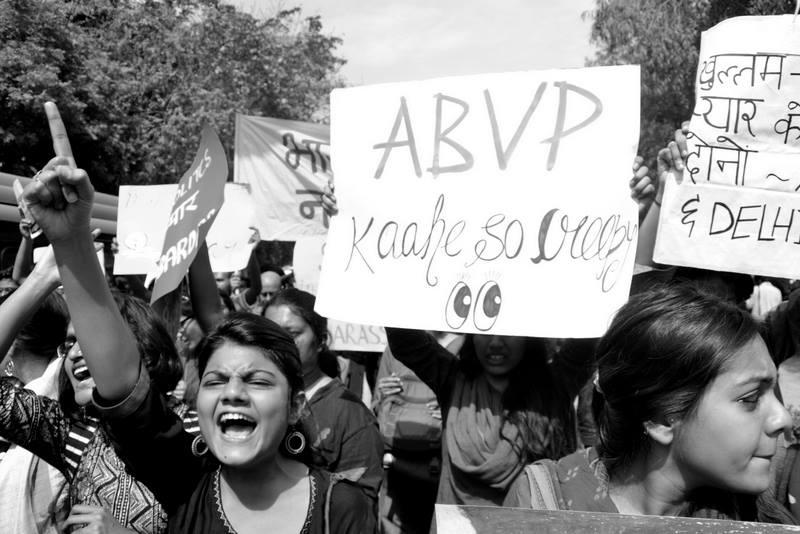
Why do you think it is important for students to study and understand cultures of protest, and why do you think it is important in a democracy?
Abinash: The seminar began with the idea of exploring protest and dissent in everyday life. We wanted to explore this through bodies, universities, caste, class, and gender.
It is very important to understand non-conformist views. Part of university culture is to challenge the structures of knowledge: to understand that knowledge comes from a source, and that we can question it; that we can counter these hegemonising voices through protests and dissenting voices. This was the basic idea of the seminar: to understand how protest occurs. I was having a conversation with my teacher about the Manipuri women, who had protested through their bodies against the army. We tried to understand how the "body as weapon" was an important form of protest. And that’s how things grew. We tried to understand little moments of protest, and it became a larger “cultures of protest”…
The idea of discussing protest at this time is extremely significant. We live in a fascist regime. To talk about protest is “seditious”.
Mrinalini: We wanted to create a platform where we could meet and ask questions. If the ABVP had a problem, they could have attended the seminar and asked questions. That would have led to discussion and debate…
There was a dramatic shift, where debate and dialogue on cultures of protest ironically moved out of the inner space of the seminar, into action and protest outside. Did this change the way you look at education, and your own studies within the four walls of the classroom?
Abinash: That is an interesting question, but it creates a binary. Social science is praxis in itself… and protest is a part of the social sciences — we protest everyday, every moment. Killing our protest kills us, as well as our classroom spaces.
Sourya: “Liberal” colleges such as Ashoka University talk of, and represent, a particular “diversity”. But there are many meanings of diversity. We would not have seen the kind of numbers at the protest today, had DU not been a diverse institution… This, really, is education — it is about changing the way knowledge itself is produced.
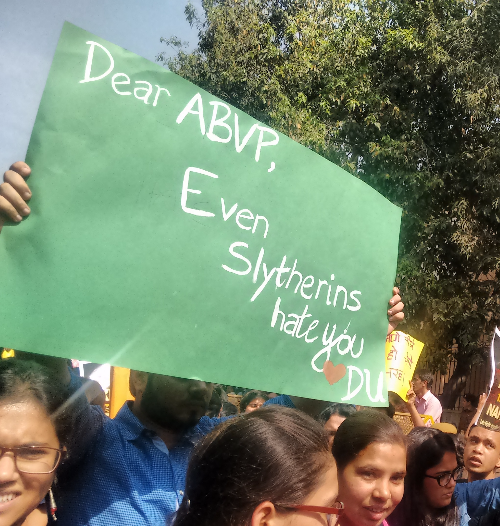
Slogans of azadi reverberated across North Campus today. What does azadi mean to you?
Sourya: An interesting thing about azadi is that it does not have a clear definition. For example, in JNU, BAPSA is redefining azadi in a particular way, Kanhaiya Kumar in another, and then azadi means something else in Kashmir. "Azadi" is giving people the space to define [and demand] azadi for themselves.
Mrinalini: Azadi for me is about liberation and freedom. Our freedom of speech in democratic spaces is being stopped by violent methods — we are not allowed to say what we feel… Azadi also means freedom from the self, from the individual.
Prajalya: I remember Kanhaiya Kumar saying last year that “Bharat se azadi nahin, bharat mein azadi chahiye.” This concept of “Bharat mein azadi”: we do not have the freedom to dress [as we like], to sing, to speak, to hold seminars… Azadi means freedom from oppression.
I don’t understand why they have a problem with azadi.
Siddhanth: Azadi means freedom from AFSPA, or from the suffering and atrocities in Bastar. It has been interpreted negatively, and the media has fuelled this.
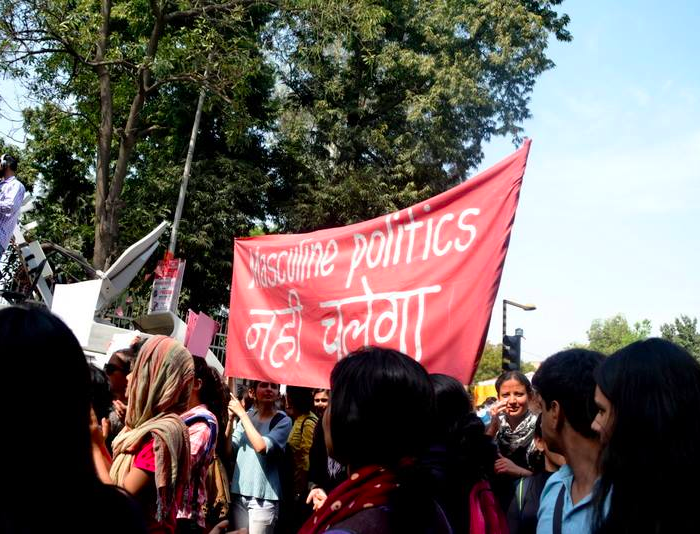
Do you think student politics is the best way by which the ideas of ABVP and right-wing ideology can be challenged?
Shambhawi: There is no other way. How else do you fight ABVP, which also works with a certain ideology? We need sharp articulation to counter them.
Are there other ways of resistance and mobilisation?
Shambhawi: Of course, there is a need to organise and speak to students…
[For instance], there is a certain form of masculinity that is exerted during the elections, by both NSUI as well as the ABVP. It is necessary for us to change this. Pinjra Tod has been an important space because it is a women’s collective in DU, and we have militantly challenged ABVP’s stronghold and their masculinity. They are always confused about what to do with us: “Baap aur khaap se azadi kyun chahti hain?” — they cannot fathom this.
Should resistance be under the umbrella of AISA, or should we do away with this binary of AISA versus ABVP?
Shambhawi: AISA should definitely not try to take over the space, and allow this moment to unfold. This moment has so many possibilities, and AISA can extinguish it. They have a certain way of doing things, they have a history; and some people don’t want to be, and cannot associate with it. But they still want to do things. So how do you create that space? All students were very angry at the way they were hijacking spaces.
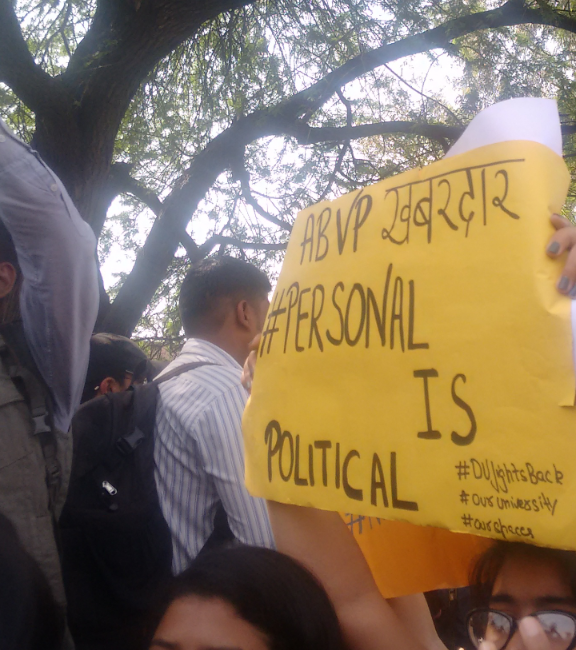
At the protest today, the media, much like the ABVP, were violating and intruding into spaces. What do you make of the media’s role?
Shambhawi: The media often thrusts the mike at us. They don’t even take our consent to be on camera. Especially now, when the ABVP is identifying people, the media should respect that.
Secondly, the media has represented it as left versus right, or a “clash”. There has been a strong counter-narrative to this. Today a large number of people came from various colleges, and we could see how shocked they were; they weren’t expecting such large numbers.
Sourya: On 22 February, we protested against the ABVP, and a lot of students and teachers were injured. At the same time, at Gumped, a village in Chhattisgarh, twenty-two adivasis were critically injured, their houses were burnt down, and women alleged rape. This was not even in the news. This is the regular modus operandi.
Siddhanth: The ABVP [and other right wing ideologues] only cherishes the idea of a nation. They do not care for the oppressed, and are merely concerned with the nation’s geographical integrity. They fear the emergence of a narrative that is different from their own. That is very problematic. It is only when we are inclusive that we can go ahead and celebrate the idea of a nation.
How do you interpret this collective of resistance “Save DU”?
Shambhawi: Some of us have been actively questioning the university and its patriarchal and casteist structure, which already exists. We cannot reclaim DU or “Save DU” — if anything, we have to rebuild it.

¹From "The Question of Social Transformation", in Undoing Gender by Judith Butler.
Disclaimer: The views expressed here are the author's personal views, and do not necessarily represent the views of Newsclick.
Get the latest reports & analysis with people's perspective on Protests, movements & deep analytical videos, discussions of the current affairs in your Telegram app. Subscribe to NewsClick's Telegram channel & get Real-Time updates on stories, as they get published on our website.























